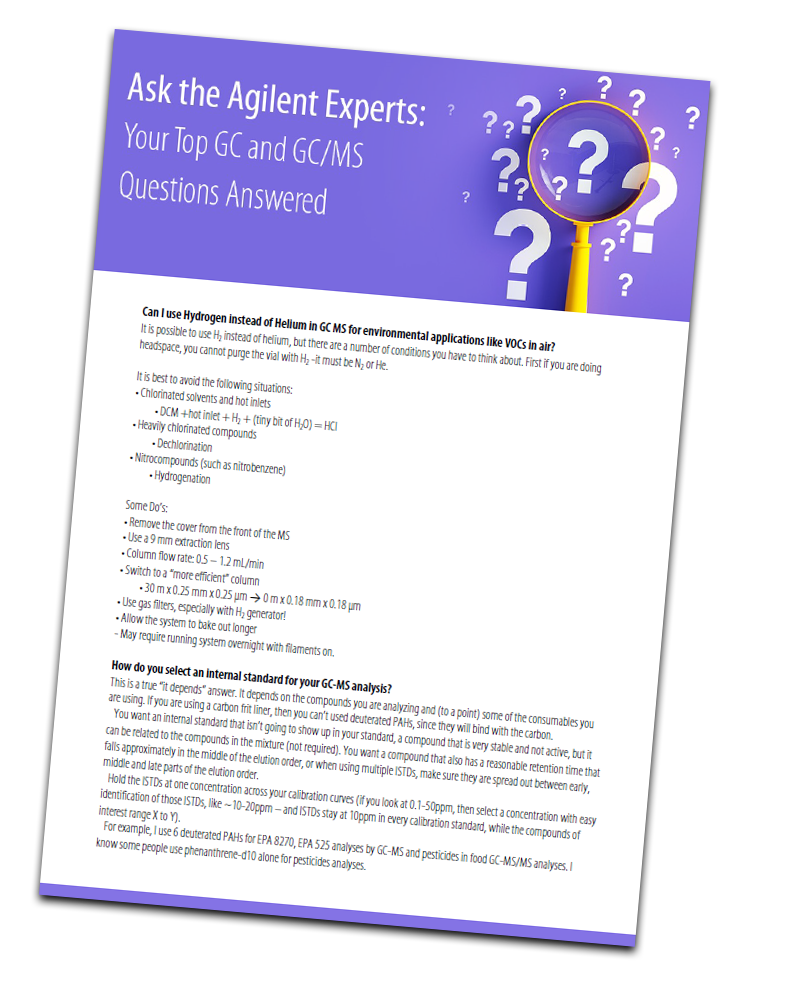Have you ever had a question about your GC/GCMS analysis and thought, "I have no idea what to do," or that because the question seemed so simple, everyone must already know the answer and "I’m the only one who doesn’t know what to do." We can assure you that you are not alone. If you would like to find the answers to some of these most frequently asked questions, register for this on-demand webinar.

Format: On-demand
Duration: Approximately 80 minutes
If you have a question, we can guarantee that you are not the first... nor the last person to ask it. Sometimes the simplest of questions can have the most complex answers. A question about which liner to use can lead to a discussion on the benefits of glass wool versus glass frits. A question about how long a column should last may trigger a discussion about the importance of a leak free system, the maximum temperature limit, proper phase selection, and how an application may benefit from using backflush.
There’s no such thing as an easy answer, because the answer always depends on many different factors. Therefore, we have complied a list of some of our most frequently asked questions, which may seem like simple questions, but in reality they have anything but simple answers.
By viewing this presentation you will learn:
- best practices with GC and GC/MS systems – from liner and column selection to why gas filters matter and instrument prep recommendations, and
- why there is not always an easy answer to most GC(MS) questions.
Plus...
 By registering, you will also get access to a PDF copy of the presenters' answers to questions that were submitted during the live webinar.
By registering, you will also get access to a PDF copy of the presenters' answers to questions that were submitted during the live webinar.
Other resources include information on Agilent's GC/MS columns and supplies, a brochure on how the right connections make all the difference, a GC column selector tool and a vapor volume calculator.
If you have a colleague who may also be interested in the subject of this webinar, please recommend it to them by using the link below.
The Presenters
 Angie Smith-Henry
Angie Smith-Henry
(Applications Chemist for GC and MS Supplies, Agilent)
Angie is is an applications chemist for GC and MS Supplies at Agilent in Wilmington, Delaware, USA. Previously, she was an applications chemist for the MSD Solutions and Applications group with a focus on developing analysers and applications for energy, chemical and environmental markets. Angie holds a PhD in Physical Chemistry from Lehigh University and BS in Chemistry from Juniata College.
 Vanessa Abercrombie
Vanessa Abercrombie
(Gas Chromatography Applications Chemist, Agilent)
Vanessa is a GC Applications Chemist at Agilent in Folsom, California, USA. Vanessa has a broad background in GC and GC/MS, including experience as an instrument chemist at Bode Technology in Virginia working under contract to the FBI’s Laboratory Division. Prior to that, Vanessa worked for ETS Labs in St. Helena, California as an Analytical Chemist where she researched and developed quantitative separations by GC/MS and UHPLC for beer, wine, and spirits. She holds a Master of Forensic Science from The George Washington University and a Bachelor of Arts in Chemistry from Sonoma State University.
Moderator: Diane Turner
Diane Turner
(Director & Senior Consultant, Anthias Consulting)
Diane Turner is Director and Senior Consultant of Anthias Consulting in Cambridgeshire, UK. A Warwick University graduate, Diane completed her masters in Analytical Chemistry and started her career in environmental chemistry, later gaining significant experience as an Applications Chemist. Diane’s area of research through her PhD studies at The Open University was disease diagnosis. She has developed methods for, and given support and training for companies in most industries around the world for more than 20 years. Diane also holds voluntary roles with The Royal Society of Chemistry and other scientific organisations.
Sponsor





